- Home
 About us
About us  History and Mission
History and Mission
History and Mission
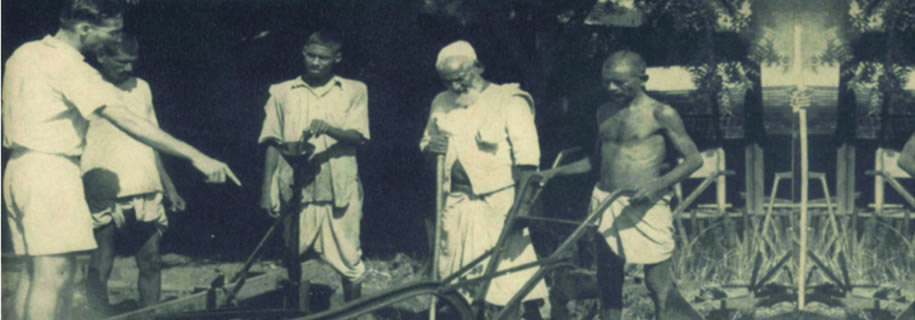
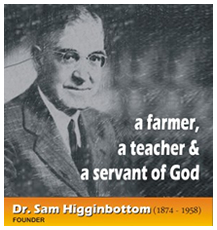
The Agricultural Institute was established
under the leadership of Dr. Sam
Higginbottom, in 1910, as an ecumenical
Institution of the Christian Churches and
Church organizations in India. Dr. Sam
Higginbottom came to India in 1903 and
joined the North India Mission of the
Presbyterian Church. From 1903 to 1909,
he taught economics and science in the
Allahabad Christian College, presently
known as Ewing Christian College, and at
the same time studied the local dialect.
During this period, he became a familiar
figure in the surrounding villages. He also
saw and observed the living conditions of
the villagers and was deeply concerned
about the ancient system of agriculture that
contributed to low productivity and thus led
to extreme poverty amongst them. He was
also genuinely disturbed by the vast gulf
between the urban Christian and the rural
masses. For several months he
contemplated upon the Christian neglect of
the villages and ultimately by the end of
1909 he decided to bridge this gulf by
establishing an agricultural school, which he
envisioned would educate the village boys,
introduce improved agricultural methods
and cooperate with the local farmers in
solving their practical agriculture related
problems.
He also took over the responsibility of
supervising a home for lepers. This home
was operated by the Allahabad Charitable
Association,but since the home did not have
adequate facilities for providing food,
clothing and shelter, the lepers often left and
wandered into the city as beggars.
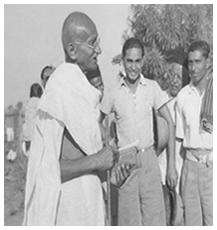
Dr. Higginbottom himself found them
repulsive as most of them had lost their
fingers and toes, their wounds were
wrapped in dung coloured rags. Dr. Sam
Higginbottom was so disturbed by the sight
that within a few weeks he asked to be
relieved of this responsibility, but Mr. Arthur
Henry Ewing, the Principal of Allahabad
Christian College, encouraged him to
continue this work. Realizing that his attitude
was inconsistent with the teachings of the
Bible, which taught to cleanse lepers, the
young missionary acknowledged that they
were indeed his brothers in Christ. This
made him look for possibilities of increasing
the financial assistance for a proper home
for lepers and thus came into being, the
present Leprosy Hospital in Naini, situated
across the Jamuna river about 1.5
kilometers south east of the city. The home
consisted of a small hospital and church and
a home for the untainted children of the
lepers. This home was the project of
Ethelind Higginbottom, wife of Dr. Sam
Higginbottom. She felt that children who
were separated within the first year of their
birth from their parents would not contact
this disease. This home was adjacent to the
Naini Jail where the superintendent Col. E.
Hudson, introduced improved agricultural
techniques on the jail farm. Dr.
Higginbottom seized upon Hudson’s
methods of farming and taught these
methods to the lepers who were able
to farm.
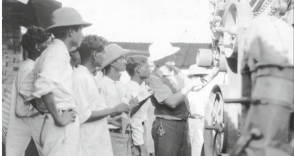
The evolution of an agricultural school was
much more complex. Dr. Sam
Higginbottom wished to establish a school
that would train young men to work in
villages as well as do research in practical
agricultural problems of the villagers. His
experiences as a teacher, his studies about
India and his association with Col. Hudson
helped him to develop this school. During
his teaching of economics, he observed
that the course was rather unrelated to the
needs of the Indian students. The books
were based on the knowledge of Western,
urbanized society, which here was
meaningless for the Indian students. The
lack of comprehension and the
impracticality of the course deeply
disturbed Dr. Higginbottom. He then
decided to aquaint his students to the
Indian economy.
Dr. Higginbottom gave his students
practical demonstration by taking them to
observe the life style of the villagers,
personally. He showed the students Col.
Hudson’s farm at the Naini Jail, so they
would have a first-hand information
regarding the possibilities of improved
agricultural methods and teaching of
practical village industries such as wood
carving, pottery, rug making, canning, etc.
Dr. Higginbottom, thus planned and started
a school which was located in the transJamuna
region on the southern bank of the
river, directly across the Allahabad Christian
College Campus. This region was
connected to the city of Allahabad by a
two-tiered wooden bridge which spanned
across the Jamuna and had a double rail
line on the top and a dirt road underneath.
About half a kilometer in the south-west
direction from this bridge the Agricultural
Institute was established in the year 1910.
About 120 kilometers down this road was
the Estate of Rewa.
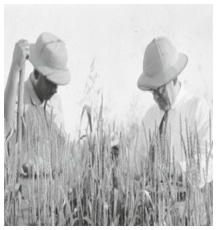
This region was one of
the poorest regions of this area, the soil
was of a very poor quality (usar), it was
barren and had not been cultivated for
years. Dr. Higginbottom took advantage of
this opportunity and along with his
associates reclaimed the area and
demonstrated the potential value of usar
and felt that the ryots would be inspired to
adopt the practices of the Agricultural
School. He had to his advantage the fact
that this school was situated on the
confluence of the Ganga – Jamuna, (known
as “the Sangam”). Every year in the months
of January and February, thousands of
pilgrims passed this way and thus they
would be able to observe and practically
see the improved methods of agriculture
which were implemented on the farm and
in return would carry these ideas with
them to the various parts of country from
where they had come. The first phase of
the Institute was its establishment,
development of appropriate training
courses and training programmes. Informal
classes began in the fall of 1912 and it was
during this period from 1912 to 1919 that
the Institute faced a time of uncertainty.
The dairy, animal husbandry and
agriculture farm were developed. Diploma
in farm machinery and dairying were
started in 1923, then a degree in
agriculture in 1932, followed by a degree
in agricultural engineering in 1943. This
became the pioneer Institute to offer
agricultural engineering degree in the
whole of Asia; and the fourth in the world.
Prof. Mason Vaugh, an agricultural
engineer, founded the Department of
Agricultural Engineering, and became the
father of Agriculture Engineering in India in
the early 1940s.
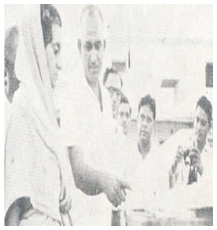
Several implements such
as Mould Board Ploughs (Wah Wah Plough,
U.P. No.1, U.P. No.2, Shabash Plough) hoes,
cultivators and wheat thresher were
introduced for the first time introduced in
India by Prof. Vaugh.
The next phase of the Institute was taken up
by Dr. A.T. Mosher, in the year 1948–49,
and the major expansion such as the
construction of the College of Agriculture,
New Hostel and many residences took place
during this period. The most famous
agriculture extension project was “Jamuna Par
Punar Yojna”, in which the “Gaon Saathi”,
(recruitment of village-level workers) was
introduced into the extension system for the
first time in India. The first planners of our
country took the idea of the ‘Village-Level
Worker’ as a community-development
model. This has now been adopted by
eleven countries of the world. In October
1947, the Institute was brought under an
independent Board of Directors, which was
sponsored as an ecumenical body by a
number of Churches and Christian Missions
called The Board of Directors. On the 25th
of Aug. 1950, the A.A.I. was registered to
function as a Christian Educational Institute of
a national stature.

Dr. J.B. Chitamber, a famous extension
scientist, took over the reigns of the Institute.
Major academic expansion took place during
this period, i.e., from 1950 till 1980. Dr.
Chitamber who had worked
very closely with Dr. A. T. Mosher, led the
Institute successfully and made extension a
very well-known programme of the
Institute. From the year 1980 to 1995 the
Institute faced financial and administrative
crisis, the worst in its history and suffered the
severest bankruptcy, due to which land had
to be sold for disbursement of salaries, as
employees were not paid for ten to twelve
months. All fixed deposits dried out.
However, through the prayer of believers
and by the grace of the Lord Jesus Christ, as
the people started realizing the vision of the
founders, the spirit of the Lord once again
started working in the Institute and by the
end of the year 1996 the Institute survived
and came out of this crisis.
In order to obtain more academic freedom
and to strengthen the specialized
programmes of teaching, research and
extension a proposal was submitted to the
Ministry of Human Resource Development,
Govt. of India by the Director Dr. Rajendra
B. Lal on the 31st of August 1994, that the
Institute be granted the status of a Deemed
University.
In 1997, a team of experts from
ICAR and UGC visited the Institute and
gave their recommendation that the
Institute be declared as a Deemed
University, as it had all the potentials of a
university. On the 15th of March 2000, Dr.
Murli Manohar Joshi, Hon’ble Minister of
Human Resource Development, Govt. of
India, gave his approval to the
recommendations of the UGC. The
Central Government issued the notification
No. F-9-26/94-U.3. dated the 15th of
March 2000, declaring the Allahabad
Agricultural Institute-as Deemed University
and Most Rev. Prof. Rajendra B. Lal, was
appointed as the first Vice-Chancellor of the
University. Today, under the dynamic and
vibrant leadership of Most Rev. Prof.
Rajendra B. Lal, the University has been
accredited with “A Grade” by National
Assessment and Accreditation Council (an
autonomous body of UGC) in 2013. In
2009, Indian Council of Agricultural
Research (ICAR) and in 2010, Indian Council
for Forest Research Education (ICFRE) also
accredited SHUATS. SHUATS is an ISO
9001:2008 certified institution serving the
nation for the past 106 years.
As a tribute to the founder Dr. Sam
Higginbottom, who through his sincere
services, hard work and dedication, has
contributed greatly towards enhancing the
agriculture production in our country, a
proposal was submitted to Ministry of
Human Resource Development, Govt. of
India, New Delhi to rechristen Allahabad
Agricultural Institute-Deemed University as
“Sam Higginbottom Institute of Agriculture,
Technology and Sciences”. In view of the
above, Ministry of Human Resource
Development, Govt. of India, New Delhi
vide communication bearing reference No.
F.13-7/2008-U.3.A, dated September 22,
2009 has permitted rechristenng of the
Allahabad Agricultural Institute-Deemed
University as: “SAM HIGGINBOTTOM
INSTITUTE OF AGRICULTURE,
TECHNOLOGY & SCIENCES” (Formerly
Allahabad Agricultural Institute), (Deemed-tobe-University).
To upgrade the Deemed University to a full
fledged University under State Act, Hon’ble
Vice Chancellor, Most Rev. Prof. Rajendra B.
Lal tirelessly worked hard in pursuing the
University Act with the State Government
from the year 2010.
Due to the hard and painstaking efforts of the
Hon’ble Vice Chancellor and, after
considering the adequate availability of
teaching / non-teaching staff and other
essential infrastructure facilities in the Sam
Higginbottom Institute of Agriculture,
Technology & Sciences - Deemed
University(SHUATS), Allahabad, the Uttar
Pradesh Legislature decided to upgrade,
reconstitute and establish SHUATS as a fullfledged
University under the State Act so as
to ensure successive development of
Agricultural Education, Research, Extension,
Science, Technology and other disciplines in
the State. The Uttar Pradesh Legislature was
pleased to pass the Sam Higginbottom
University of Agriculture, Technology And
Sciences, Uttar Pradesh Act, 2016 (U.P. Act
No. 35 of 2016). Hon'ble Governor of Uttar
Pradesh has very kindly given his assent to the
aforesaid Act on December 27, 2016.
Sam Higginbottom University of Agriculture,
Technology And Sciences, Uttar Pradesh Act,
2016 has been notified in the official Gazette
vide Notification No. 1867/79-V-1-16-
1(ka)36-2016 dated December 27, 2016.
Vide Notification No. 2473/67-KSA-2016-
900(2)/2010, dated December 29, 2016,
Hon'ble Governor, Uttar Pradesh was
pleased to appoint December 29, 2016 as
the date on which the aforesaid Act would
come into force.

 About us
About us 
 The Agricultural Institute was established
under the leadership of Dr. Sam
Higginbottom, in 1910, as an ecumenical
Institution of the Christian Churches and
Church organizations in India. Dr. Sam
Higginbottom came to India in 1903 and
joined the North India Mission of the
Presbyterian Church. From 1903 to 1909,
he taught economics and science in the
Allahabad Christian College, presently
known as Ewing Christian College, and at
the same time studied the local dialect.
During this period, he became a familiar
figure in the surrounding villages. He also
saw and observed the living conditions of
the villagers and was deeply concerned
about the ancient system of agriculture that
contributed to low productivity and thus led
to extreme poverty amongst them. He was
also genuinely disturbed by the vast gulf
between the urban Christian and the rural
masses. For several months he
contemplated upon the Christian neglect of
the villages and ultimately by the end of
1909 he decided to bridge this gulf by
establishing an agricultural school, which he
envisioned would educate the village boys,
introduce improved agricultural methods
and cooperate with the local farmers in
solving their practical agriculture related
problems.
He also took over the responsibility of
supervising a home for lepers. This home
was operated by the Allahabad Charitable
Association,but since the home did not have
adequate facilities for providing food,
clothing and shelter, the lepers often left and
wandered into the city as beggars.
The Agricultural Institute was established
under the leadership of Dr. Sam
Higginbottom, in 1910, as an ecumenical
Institution of the Christian Churches and
Church organizations in India. Dr. Sam
Higginbottom came to India in 1903 and
joined the North India Mission of the
Presbyterian Church. From 1903 to 1909,
he taught economics and science in the
Allahabad Christian College, presently
known as Ewing Christian College, and at
the same time studied the local dialect.
During this period, he became a familiar
figure in the surrounding villages. He also
saw and observed the living conditions of
the villagers and was deeply concerned
about the ancient system of agriculture that
contributed to low productivity and thus led
to extreme poverty amongst them. He was
also genuinely disturbed by the vast gulf
between the urban Christian and the rural
masses. For several months he
contemplated upon the Christian neglect of
the villages and ultimately by the end of
1909 he decided to bridge this gulf by
establishing an agricultural school, which he
envisioned would educate the village boys,
introduce improved agricultural methods
and cooperate with the local farmers in
solving their practical agriculture related
problems.
He also took over the responsibility of
supervising a home for lepers. This home
was operated by the Allahabad Charitable
Association,but since the home did not have
adequate facilities for providing food,
clothing and shelter, the lepers often left and
wandered into the city as beggars.
 Dr. Higginbottom himself found them
repulsive as most of them had lost their
fingers and toes, their wounds were
wrapped in dung coloured rags. Dr. Sam
Higginbottom was so disturbed by the sight
that within a few weeks he asked to be
relieved of this responsibility, but Mr. Arthur
Henry Ewing, the Principal of Allahabad
Christian College, encouraged him to
continue this work. Realizing that his attitude
was inconsistent with the teachings of the
Bible, which taught to cleanse lepers, the
young missionary acknowledged that they
were indeed his brothers in Christ. This
made him look for possibilities of increasing
the financial assistance for a proper home
for lepers and thus came into being, the
present Leprosy Hospital in Naini, situated
across the Jamuna river about 1.5
kilometers south east of the city. The home
consisted of a small hospital and church and
a home for the untainted children of the
lepers. This home was the project of
Ethelind Higginbottom, wife of Dr. Sam
Higginbottom. She felt that children who
were separated within the first year of their
birth from their parents would not contact
this disease. This home was adjacent to the
Naini Jail where the superintendent Col. E.
Hudson, introduced improved agricultural
techniques on the jail farm. Dr.
Higginbottom seized upon Hudson’s
methods of farming and taught these
methods to the lepers who were able
to farm.
Dr. Higginbottom himself found them
repulsive as most of them had lost their
fingers and toes, their wounds were
wrapped in dung coloured rags. Dr. Sam
Higginbottom was so disturbed by the sight
that within a few weeks he asked to be
relieved of this responsibility, but Mr. Arthur
Henry Ewing, the Principal of Allahabad
Christian College, encouraged him to
continue this work. Realizing that his attitude
was inconsistent with the teachings of the
Bible, which taught to cleanse lepers, the
young missionary acknowledged that they
were indeed his brothers in Christ. This
made him look for possibilities of increasing
the financial assistance for a proper home
for lepers and thus came into being, the
present Leprosy Hospital in Naini, situated
across the Jamuna river about 1.5
kilometers south east of the city. The home
consisted of a small hospital and church and
a home for the untainted children of the
lepers. This home was the project of
Ethelind Higginbottom, wife of Dr. Sam
Higginbottom. She felt that children who
were separated within the first year of their
birth from their parents would not contact
this disease. This home was adjacent to the
Naini Jail where the superintendent Col. E.
Hudson, introduced improved agricultural
techniques on the jail farm. Dr.
Higginbottom seized upon Hudson’s
methods of farming and taught these
methods to the lepers who were able
to farm.
 The evolution of an agricultural school was
much more complex. Dr. Sam
Higginbottom wished to establish a school
that would train young men to work in
villages as well as do research in practical
agricultural problems of the villagers. His
experiences as a teacher, his studies about
India and his association with Col. Hudson
helped him to develop this school. During
his teaching of economics, he observed
that the course was rather unrelated to the
needs of the Indian students. The books
were based on the knowledge of Western,
urbanized society, which here was
meaningless for the Indian students. The
lack of comprehension and the
impracticality of the course deeply
disturbed Dr. Higginbottom. He then
decided to aquaint his students to the
Indian economy.
Dr. Higginbottom gave his students
practical demonstration by taking them to
observe the life style of the villagers,
personally. He showed the students Col.
Hudson’s farm at the Naini Jail, so they
would have a first-hand information
regarding the possibilities of improved
agricultural methods and teaching of
practical village industries such as wood
carving, pottery, rug making, canning, etc.
Dr. Higginbottom, thus planned and started
a school which was located in the transJamuna
region on the southern bank of the
river, directly across the Allahabad Christian
College Campus. This region was
connected to the city of Allahabad by a
two-tiered wooden bridge which spanned
across the Jamuna and had a double rail
line on the top and a dirt road underneath.
About half a kilometer in the south-west
direction from this bridge the Agricultural
Institute was established in the year 1910.
About 120 kilometers down this road was
the Estate of Rewa.
The evolution of an agricultural school was
much more complex. Dr. Sam
Higginbottom wished to establish a school
that would train young men to work in
villages as well as do research in practical
agricultural problems of the villagers. His
experiences as a teacher, his studies about
India and his association with Col. Hudson
helped him to develop this school. During
his teaching of economics, he observed
that the course was rather unrelated to the
needs of the Indian students. The books
were based on the knowledge of Western,
urbanized society, which here was
meaningless for the Indian students. The
lack of comprehension and the
impracticality of the course deeply
disturbed Dr. Higginbottom. He then
decided to aquaint his students to the
Indian economy.
Dr. Higginbottom gave his students
practical demonstration by taking them to
observe the life style of the villagers,
personally. He showed the students Col.
Hudson’s farm at the Naini Jail, so they
would have a first-hand information
regarding the possibilities of improved
agricultural methods and teaching of
practical village industries such as wood
carving, pottery, rug making, canning, etc.
Dr. Higginbottom, thus planned and started
a school which was located in the transJamuna
region on the southern bank of the
river, directly across the Allahabad Christian
College Campus. This region was
connected to the city of Allahabad by a
two-tiered wooden bridge which spanned
across the Jamuna and had a double rail
line on the top and a dirt road underneath.
About half a kilometer in the south-west
direction from this bridge the Agricultural
Institute was established in the year 1910.
About 120 kilometers down this road was
the Estate of Rewa.
 This region was one of
the poorest regions of this area, the soil
was of a very poor quality (usar), it was
barren and had not been cultivated for
years. Dr. Higginbottom took advantage of
this opportunity and along with his
associates reclaimed the area and
demonstrated the potential value of usar
and felt that the ryots would be inspired to
adopt the practices of the Agricultural
School. He had to his advantage the fact
that this school was situated on the
confluence of the Ganga – Jamuna, (known
as “the Sangam”). Every year in the months
of January and February, thousands of
pilgrims passed this way and thus they
would be able to observe and practically
see the improved methods of agriculture
which were implemented on the farm and
in return would carry these ideas with
them to the various parts of country from
where they had come. The first phase of
the Institute was its establishment,
development of appropriate training
courses and training programmes. Informal
classes began in the fall of 1912 and it was
during this period from 1912 to 1919 that
the Institute faced a time of uncertainty.
The dairy, animal husbandry and
agriculture farm were developed. Diploma
in farm machinery and dairying were
started in 1923, then a degree in
agriculture in 1932, followed by a degree
in agricultural engineering in 1943. This
became the pioneer Institute to offer
agricultural engineering degree in the
whole of Asia; and the fourth in the world.
Prof. Mason Vaugh, an agricultural
engineer, founded the Department of
Agricultural Engineering, and became the
father of Agriculture Engineering in India in
the early 1940s.
This region was one of
the poorest regions of this area, the soil
was of a very poor quality (usar), it was
barren and had not been cultivated for
years. Dr. Higginbottom took advantage of
this opportunity and along with his
associates reclaimed the area and
demonstrated the potential value of usar
and felt that the ryots would be inspired to
adopt the practices of the Agricultural
School. He had to his advantage the fact
that this school was situated on the
confluence of the Ganga – Jamuna, (known
as “the Sangam”). Every year in the months
of January and February, thousands of
pilgrims passed this way and thus they
would be able to observe and practically
see the improved methods of agriculture
which were implemented on the farm and
in return would carry these ideas with
them to the various parts of country from
where they had come. The first phase of
the Institute was its establishment,
development of appropriate training
courses and training programmes. Informal
classes began in the fall of 1912 and it was
during this period from 1912 to 1919 that
the Institute faced a time of uncertainty.
The dairy, animal husbandry and
agriculture farm were developed. Diploma
in farm machinery and dairying were
started in 1923, then a degree in
agriculture in 1932, followed by a degree
in agricultural engineering in 1943. This
became the pioneer Institute to offer
agricultural engineering degree in the
whole of Asia; and the fourth in the world.
Prof. Mason Vaugh, an agricultural
engineer, founded the Department of
Agricultural Engineering, and became the
father of Agriculture Engineering in India in
the early 1940s.
 Several implements such
as Mould Board Ploughs (Wah Wah Plough,
U.P. No.1, U.P. No.2, Shabash Plough) hoes,
cultivators and wheat thresher were
introduced for the first time introduced in
India by Prof. Vaugh.
The next phase of the Institute was taken up
by Dr. A.T. Mosher, in the year 1948–49,
and the major expansion such as the
construction of the College of Agriculture,
New Hostel and many residences took place
during this period. The most famous
agriculture extension project was “Jamuna Par
Punar Yojna”, in which the “Gaon Saathi”,
(recruitment of village-level workers) was
introduced into the extension system for the
first time in India. The first planners of our
country took the idea of the ‘Village-Level
Worker’ as a community-development
model. This has now been adopted by
eleven countries of the world. In October
1947, the Institute was brought under an
independent Board of Directors, which was
sponsored as an ecumenical body by a
number of Churches and Christian Missions
called The Board of Directors. On the 25th
of Aug. 1950, the A.A.I. was registered to
function as a Christian Educational Institute of
a national stature.
Several implements such
as Mould Board Ploughs (Wah Wah Plough,
U.P. No.1, U.P. No.2, Shabash Plough) hoes,
cultivators and wheat thresher were
introduced for the first time introduced in
India by Prof. Vaugh.
The next phase of the Institute was taken up
by Dr. A.T. Mosher, in the year 1948–49,
and the major expansion such as the
construction of the College of Agriculture,
New Hostel and many residences took place
during this period. The most famous
agriculture extension project was “Jamuna Par
Punar Yojna”, in which the “Gaon Saathi”,
(recruitment of village-level workers) was
introduced into the extension system for the
first time in India. The first planners of our
country took the idea of the ‘Village-Level
Worker’ as a community-development
model. This has now been adopted by
eleven countries of the world. In October
1947, the Institute was brought under an
independent Board of Directors, which was
sponsored as an ecumenical body by a
number of Churches and Christian Missions
called The Board of Directors. On the 25th
of Aug. 1950, the A.A.I. was registered to
function as a Christian Educational Institute of
a national stature.
 Dr. J.B. Chitamber, a famous extension
scientist, took over the reigns of the Institute.
Major academic expansion took place during
this period, i.e., from 1950 till 1980. Dr.
Chitamber who had worked
very closely with Dr. A. T. Mosher, led the
Institute successfully and made extension a
very well-known programme of the
Institute. From the year 1980 to 1995 the
Institute faced financial and administrative
crisis, the worst in its history and suffered the
severest bankruptcy, due to which land had
to be sold for disbursement of salaries, as
employees were not paid for ten to twelve
months. All fixed deposits dried out.
However, through the prayer of believers
and by the grace of the Lord Jesus Christ, as
the people started realizing the vision of the
founders, the spirit of the Lord once again
started working in the Institute and by the
end of the year 1996 the Institute survived
and came out of this crisis.
In order to obtain more academic freedom
and to strengthen the specialized
programmes of teaching, research and
extension a proposal was submitted to the
Ministry of Human Resource Development,
Govt. of India by the Director Dr. Rajendra
B. Lal on the 31st of August 1994, that the
Institute be granted the status of a Deemed
University.
Dr. J.B. Chitamber, a famous extension
scientist, took over the reigns of the Institute.
Major academic expansion took place during
this period, i.e., from 1950 till 1980. Dr.
Chitamber who had worked
very closely with Dr. A. T. Mosher, led the
Institute successfully and made extension a
very well-known programme of the
Institute. From the year 1980 to 1995 the
Institute faced financial and administrative
crisis, the worst in its history and suffered the
severest bankruptcy, due to which land had
to be sold for disbursement of salaries, as
employees were not paid for ten to twelve
months. All fixed deposits dried out.
However, through the prayer of believers
and by the grace of the Lord Jesus Christ, as
the people started realizing the vision of the
founders, the spirit of the Lord once again
started working in the Institute and by the
end of the year 1996 the Institute survived
and came out of this crisis.
In order to obtain more academic freedom
and to strengthen the specialized
programmes of teaching, research and
extension a proposal was submitted to the
Ministry of Human Resource Development,
Govt. of India by the Director Dr. Rajendra
B. Lal on the 31st of August 1994, that the
Institute be granted the status of a Deemed
University.